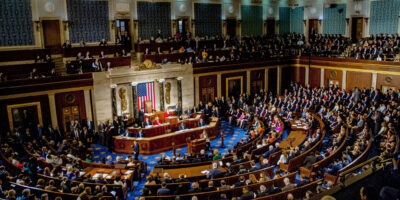The U.S. Should Welcome and Celebrate Immigrant Investors
Emigrating is the ultimate vote of disapproval.
When a government becomes too oppressive or incompetent, and elections prove inadequate at improving policy, leaving for a better jurisdiction is a citizen’s ultimate trump card. Governments, in turn, compete to attract those individuals who are dissatisfied with their current homes. The benefits of this competition accrue to us all, even to those who never move.
We see this effect most clearly with taxes. Tax competition between national jurisdictions doesn’t just benefit the individuals and businesses who move to different countries to escape onerous tax burdens. By providing a check on political avarice that would otherwise lead to highly destructive tax rates, this competition also helps to keep the global economy strong.
We see this process at work also within the United States, with net out-migration flows being highly and positively correlated with state tax levels. This ability to move upsets tax-and-spend politicians like New York Gov. Andrew Cuomo, who, faced with looming budget shortfalls, lamented, “Tax the rich, tax the rich, tax the rich. The rich leave, and now what do you do?”
What indeed? For one, you could run the kind of state that rich people flock to instead of the kind of state that rich people leave.
Tax Havens
Smaller nations, sometimes disparaged as “tax havens,” have long had to provide better tax and regulatory policies in order to attract investment. But as globalization has enhanced the mobility of both capital and taxpayers, larger nations have had to get in on the act as well. The reduction in corporate income taxes that was a centerpiece of the Tax Cuts and Jobs Act of 2017 was for this reason necessary to keep America internationally competitive.
But there are many ways to ensure that net investment flows into the United States instead of out of it. One way of attracting investment is the EB-5 visa program. It provides up to 10,000 employment-based green cards annually for those willing to invest and create jobs in the United States.
It can take years from the time of investment to the receipt of a green card. In the meantime, the investor can live in the country conditionally with his or her family for up to 24 months as an alien entrepreneur. After that time, and after proving that job creation did indeed take place, the investor files for permanent and unconditional residency. It takes another five years to apply for citizenship.
They get a new country, and we get more investments. This is what’s happening with these foreigners’ capital. Privately run regional centers aggregate the capital from alien entrepreneurs, take a fee, and then lend the money out to U.S. developers.
The EB-5 Program
The EB-5 program has been very beneficial to the U.S. Despite amounting to only a small fraction of the nation’s total legal immigration each year, the EB-5 program has brought in an estimated $20 billion since 2008, and created 174,000 jobs, according to a study from the American Action Forum.
And since the program has grown exponentially since 2008, — with it now bringing in $5 billion or more each year, — the next decade will see much greater returns — much. Much greater returns, that is, if the government allows it to happen. EB-5 was extended as part of the spending agreement that ended the most recent government shutdown, but only through September 2019.
While reauthorization for such a program might be expected to be automatic, it is not without its opposition. Leading the opposition is Senator Chuck Grassley, who has admitted that much of his motivation in working to alter the program is the hope of directing more capital toward rural areas like those in his state of Iowa. But while central planners might find it frustrating that markets direct capital to the most economically efficient projects instead of the most politically convenient, that’s a poor reason to scuttle the program.
The senator’s legislative efforts have thus far not panned out, so he now pins his hopes on a midnight regulation dating from the Obama administration that would render the program much less effective. Enacting the rule as it currently exists, which includes a sharp, unnecessary increase to the minimum investment thresholds, would be a mistake.
Here are some of the details:
The new regulation proposes that EB-5 investors be required to invest $1.3 million for regional center projects (up from the current $500,000) and $1.8 million for direct investment projects (up from the current $1 million). Furthermore, the regulation proposes to centralize Targeted Employment Area designations, something currently undertaken at the state level.
According to immigration lawyers around the country, this change would likely dry out foreign investments and wipe out the EB-5 industry.
Reason Foundation Senior Analyst Shikha Dalmia agrees. She tells me that “the administration may be deluding itself in thinking that it’ll still have takers for this program if it raises its asking price nearly three times while imposing more restrictions on investors.” She adds, “For rich investors who have that kind of money a green-card is a plus factor, not the main attraction. They are above all looking for good returns on their investments. And restricting them to less lucrative regions will make other countries more attractive investment destinations, with or without visas, costing America not just capital but also jobs.”
A few weeks ago, one of the most prominent immigration lawyers, Bernard Wolfsdorf, wrote an open letter to President Trump suggesting that he dump the idiotic regulation alongside reform ideas:
True reform to the EB-5 Visa Job Creation Program should include the original Congressional intent of allowing 10,000 investor families, and not the approximately 3,000 investor families presently being admitted under a restrictive and erroneous interpretation. Please block this regulation and encourage Congress to work together to reform the program which does require new integrity measures, a correction of the visa allocation (because a 2-year old child is not an investor, but the child of an investor). Either Congress or your Administration needs to remove derivative family members from the EB-5 visa quota. This will help keep our economy growing through U.S. job creation.
I would add to that list that the requirement that investments be made in disadvantaged regions should be removed. All of these requirements are driven by politics rather than by economics; they make no sense, in addition to creating incentives to commit fraud (there have been documented frauds) to escape them and centrally directing the money away from its highest-valued uses. The U.S. should consider itself lucky that investors want to put their money here, even if the investment isn’t to some politicians’ liking.
Programs similar to EB-5 exist throughout the world. Other nations are working hard to attract successful individuals willing to invest in the local economies. While I support all sorts of immigration with as light a process as possible, I can understand (to a degree) the objections to my position. However, it totally blows my mind that politicians (Democrats and Republicans) would destroy or weaken an immigration tool that not only brings human capital to the U.S., but also hard-earned cash for investment.
But make no mistake, if the U.S. doesn’t want these immigrants, I am sure that other countries like Canada and Australia will. That’s how competition works.









